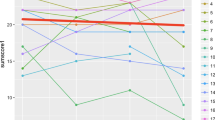Abstract
This paper examines the use of “pacing plots” to represent variations in student learning sequences within a digital curriculum. Pacing plots are an intuitive and flexible data visualizations that have a potential for revealing the diversity of blended classroom instructional models. By using curriculum pacing plots, we identified several common implementation patterns in real-world classrooms. After analyzing two years’ worth of data from over 150,000 students in a digital math curriculum, we found that a PCA and K-Means clustering approach was able to discover pedagogically relevant instructional practices.
Access this chapter
Tax calculation will be finalised at checkout
Purchases are for personal use only
Similar content being viewed by others
References
Barr, R., Dreeben, R.: How Schools Work, p. 33 (1991)
Chi, M., VanLehn, K., Litman, D.: Do micro-level tutorial decisions matter: applying reinforcement learning to induce pedagogical tutorial tactics. In: Aleven, V., Kay, J., Mostow, J. (eds.) ITS 2010. LNCS, vol. 6094, pp. 224–234. Springer, Heidelberg (2010). https://doi.org/10.1007/978-3-642-13388-6_27
Hansen, C., Hansen, C., Hjuler, N., Alstrup, S., Lioma, C.: Sequence modelling for analysing student interaction with educational systems. In: Proceedings of the 10th International Conference on Educational Data Mining (2017)
Hoadley, U.: Time to learn: pacing and the external framing of teachers’ work. J. Educ. Teach. Int. Res. Pedag. 29(3), 265–277 (2003)
Keogh, E., Mueen, A.: Curse of Dimensionality. In: Sammut, C., Webb, G.I. (eds.) Encyclopedia of Machine Learning and Data Mining, pp. 314–315. Springer, Boston (2017). https://doi.org/10.1007/978-1-4899-7687-1_192
Koedinger, K.R., Brunskill, E., Baker, R.S., McLaughlin, E.A., Stamper, J.: New potentials for data-driven intelligent tutoring system development and optimization. AI Mag. 34(3), 27–41 (2013)
Pardos, Z.A., Tang, S., Davis, D., Le, C.V.: Enabling real-time adaptivity in MOOCs with a personalized next-step recommendation framework. In: Proceedings of the 4th ACM Conference on Learning@Scale, pp. 23–32. ACM (2017)
Patel, N., Sellman, C., Lomas, D.: Mining frequent learning pathways from a large educational dataset. In: Proceedings of the 3rd International Workshop on Graph Educational Data Mining, pp. 27–30 (2017)
Reich, J.: Rebooting MOOC research. Science 347(6217), 34–35 (2015)
Romero, C., Ventura, S., Pechenizkiy, M., Baker, R.S.: Handbook of Educational Data Mining. CRC Press, Boca Raton (2010)
Smith, J., Smith, B., Bryk, A.: Setting the pace: opportunities to learn in Chicago public elementary schools. Technical report (1998)
Zhou, G., Wang, J., Lynch, C.F., Chi, M.: Towards closing the loop: bridging machine-induced pedagogical policies to learning theories. In: Proceedings of the 10th International Conference on Educational Data Mining, pp. 112–119 (2017)
Author information
Authors and Affiliations
Corresponding author
Editor information
Editors and Affiliations
Rights and permissions
Copyright information
© 2018 Springer International Publishing AG, part of Springer Nature
About this paper
Cite this paper
Patel, N., Sharma, A., Sellman, C., Lomas, D. (2018). Curriculum Pacing: A New Approach to Discover Instructional Practices in Classrooms. In: Nkambou, R., Azevedo, R., Vassileva, J. (eds) Intelligent Tutoring Systems. ITS 2018. Lecture Notes in Computer Science(), vol 10858. Springer, Cham. https://doi.org/10.1007/978-3-319-91464-0_38
Download citation
DOI: https://doi.org/10.1007/978-3-319-91464-0_38
Published:
Publisher Name: Springer, Cham
Print ISBN: 978-3-319-91463-3
Online ISBN: 978-3-319-91464-0
eBook Packages: Computer ScienceComputer Science (R0)




